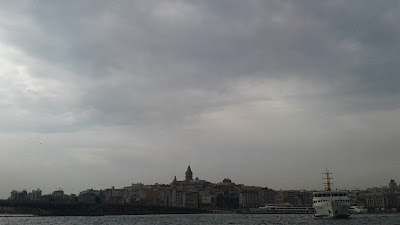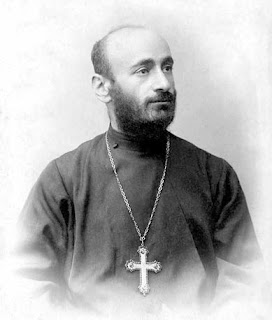Italian City States and Byzantium, a Complicated Relationship 1100 -1350
 |
| Tower of Galata, Photograph by Ahmet Abbasoğlu |
The quarters of the Italian colonies were situated
close to the harbors on the Golden Horn which is natural because of their
business. The 12th century the map of Europe saw the Normans
establish themselves in England, Almohads were in Iberia with other native
Spanish forces Castille and Aragon, at the center of Europe German “Holy Roman”
Empire stood, east of Germany were many states dispersed Hungary being one of
the stronger, a weakened Roman Empire had its capital the fashionable city of
Constantinople, Seljuks were pushing in Anatolian heartland of Byzantium,
Abbasid Caliphate lost its power and was only a name, Ayyubids were in Egypt and in
Syria and the Crusader States were scattered on the coast. As this was the fragmented
political situation, Constantinople was the center of arts and had its
influence on Russia, Venice, Southern Italy, and Sicily, three centuries before
the glory passed to the Italian city states during the Renaissance.
 |
| Location of the colonies of Italian City States Source: Wikipedia |
People, goods, arts were supported by the wealth created as a result of increased trade by the maritime traders of Italian city states. Venice, Genoa, Pisa, Amalfi… At its height one fifth of the city’s population consisted of Westerners. The Italian states, lacking land and stuck in a stalemate in their mainland they become specialized in the matters of the sea and set colonies all around the Mediterranean. They were trading between Constantinople and Egypt, Crusader states and the West.
 |
| Crossbowmen of Genoa during the storming of Jerusalem, Lazzaro Tavarone Source: Wikipedia |
After the first Crusades a sizable portion of trade in the Eastern Mediterranean was endorsed to the Genoese for their part in the invasion. That and the next hundred years Genoese were the dominant naval force in the Western Mediterranean as Pisa and Amalfi declined. Their major rival especially in the Orient would be Venice.
Byzantium certainly was in decline and possibly
envious of all that rich merchants of the west. In 1171 Venetians had their
property confiscated and all of them imprisoned by the Byzantines. Byzantine were envious of the wealth of
Italians, Italians of the culture of Byzantium. The Byzantines and the West
seemed to have an ambivalent relationship. Sometimes they traded and had been
endorsed land to live, sometimes they were punished. Venetians didn’t forget
those events though.
In 1203 Fourth Crusade was directed to Constantinople (their former patron and current trading rival) by the Venetians despite Papal excommunication and in 1204 they sacked the city. The Venetians got a full revenge; they have destroyed and looted the
city to the bone. The jewels stolen from Constantinople adorned their
churches. The famous four bronze horses of Venice were also looted from
Constantinople. And the trade in Orient changed hands from Genoa to Venice.
This stimulated the formation of a new alliance between Genoa and Michael VIII Plaiologos which stationed his capital in Nicae on the Asian side. After sometime the Byzantines reclaimed their capital (1261). Genoa was granted free trade rights in the Empire, allowed to have Aegeian sea ports on Chios, Lesbos, Smyrna. Genoa and Pisa were the only states in with trading rights in Black Sea, conquering many settlements in Crimea, establishing Caffa. It is very possible that the enemies of Venetians, Genoese were granted a colony in Galata (1273) after the Venetians were expelled from the city.
 |
| Conquest Of Constantinople By The Crusaders In 1204, 15th century miniature Source: Wikipedia |
This stimulated the formation of a new alliance between Genoa and Michael VIII Plaiologos which stationed his capital in Nicae on the Asian side. After sometime the Byzantines reclaimed their capital (1261). Genoa was granted free trade rights in the Empire, allowed to have Aegeian sea ports on Chios, Lesbos, Smyrna. Genoa and Pisa were the only states in with trading rights in Black Sea, conquering many settlements in Crimea, establishing Caffa. It is very possible that the enemies of Venetians, Genoese were granted a colony in Galata (1273) after the Venetians were expelled from the city.
 |
| Genoese fortress at Sudak, Crimea Source: Wikipedia |
Close to a century has passed.
In 1347 Black Death has spread to Constantinople from
ships trading between the capital and Crimea. The city of Caffa was under siege
by Mongols. They were using the latest biological weapon they knew; throwing
the dead bodies killed by the plague off the walls of the city which probably
let the disease spread to Europe.
This didn’t stop the Genoese from expanding the colony
and build a Romanesque tower at the northernmost point of the citadel, a year
later. The Tower of Christ (currently known as Galata Tower) was definitely built in Italian fashion. The
similarities would strike you instantly with the Tower of Pisa in Italy. It
constituted the highest point in the city. You could get to see a bird’s eye
view so you wouldn’t miss anything important in the capital across the water. It may be counted
as the satellite of medieval times.
One also thinks of the impression it might have made on
the population of Constantinople. On the other side a tower was rising, high
above the city, and they couldn’t do much but let it rise. The decline of
Constantinople and the rise of Italian city states were written in
construction. The rise of Genoa made a long lasting impact on the city’s
silhouette. |
| A close-up icluding Galata Tower from the map of Buondelmonte |
Updated on June 20, 2016

Comments
Post a Comment